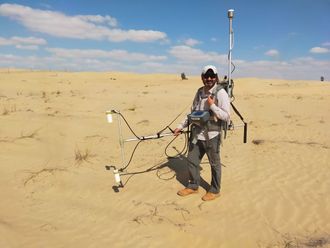
Abu Dhabi: The Emirates Mars Mission’s ‘Hope Probe’ has released its ninth dataset, featuring insights into the Martian atmosphere from the surface to the outer edges of its atmosphere daily.
This information was captured by the probe’s three science instruments: the Emirates Mars Infrared Spectrometer (EMIRS), the Emirates Mars Ultraviolet Spectrometer (EMUS), and the Emirates Exploration Imager (EXI), the UAE Space Agency said on Thursday.
After completing its primary science mission of collecting data on the Martian atmosphere for a full Martian year, an equivalent of two Earth years, the Emirates Mars Mission (EMM) is now on its extended mission to understand the inter-annual variations of the Martian atmosphere for an additional Earth year, going beyond the initial expectations set for this mission.
As part of the continuous effort to share the data with the global science community, the EMM has released its ninth dataset.
It includes data from all three instruments captured from March 1 to May 31 this year. This dataset features a collection of high-frequency cloud images, meticulously taken by EXI on April 11 and 25, 2023, May 6, 13, 18, and 22, 2023. These EXI observations allow for the study of short-term changes occurring to the clouds on Mars and their movement.
And as the Sun approaches the peak of its 11-year cycle of activity, aurora has become even more prominent in the EMUS night-side observations, with a particularly fantastic light show of discrete aurora over the strongest crustal magnetic fields in the Southern hemisphere on April 27-28, 2023.
Auroras are natural light displays that shimmer in the sky and in this case, in the Martian atmosphere.
Exceeding expectations
The space agency said the EMM mission has consistently exceeded expectations by making discoveries and capturing remarkable images. For instance, it identified new types of auroras on Mars.
Additionally, the mission obtained stunning images of Deimos, one of Mars’ smaller moons, and has continued to observe it regularly. These accomplishments demonstrate the mission’s ability to deliver more than what was initially anticipated, making it a valuable and successful endeavour in exploring the Martian environment and its phenomena.
The mission has three main science objectives that cover understanding lower atmospheric processes, upper atmosphere loss, and the link between the two. These objectives will help reveal the mysteries surrounding the Martian atmosphere and how it is lost to space.
3.3 Terabytes of data
The unique orbit of the ‘Hope probe’ allows the science community to explore the daily and seasonal variation of the Martian atmosphere by analysing the mission’s data.
With the release of the ninth batch, the Emirates Mars Mission’s ‘Hope Probe’ has now unveiled a staggering amount of 3.3 Terabytes of atmospheric data from the red planet through its Science Data Centre.
At the 74th International Astronautical Congress (IAC 2023) in Baku, Azerbaijan, the International Academy of Astronautics (IAA) honoured the Emirates Mars Mission’s ‘Hope Probe’ team with the 2023 Laurels for Team Achievement Award.
“This recognition is a tribute to their dedicated efforts in advancing our understanding of Mars. Their significant contributions include providing the global scientific community with essential data, enabling the creation of a comprehensive map of Mars’ atmosphere, and unveiling groundbreaking observations of the smaller Martian moon, Deimos,” added the UAE Space Agency.












